Each monastery has a place where relics of saints are kept. THE Ceremonial describes its ideal location: "A place is being prepared in the church building, or in adjacent places, where the relics of the saints can be kept respectfully." The ornamentation of this place is also specified. There is therefore in monasteries a use of relics. In the obituaries from other Carmels, we are told of the zeal displayed in this office by a sister of Cahors, a D'Albi, Saint-Flour, from Autun, etc.
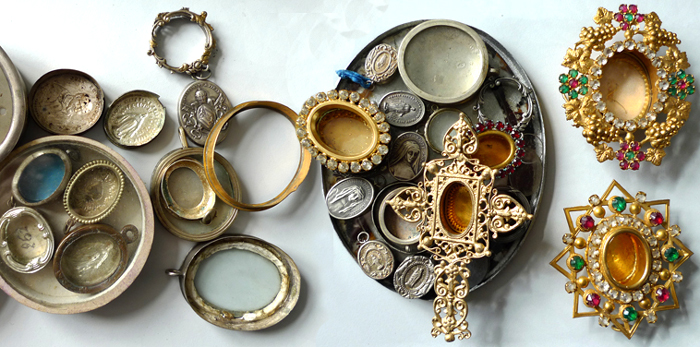
Reliquaries
At the Carmel of Lisieux, reliquaries containing relics were also prepared for the devotion of the community and for the sisters themselves. They could be relics of a single saint arranged in a very small reliquary as seen above, on a velvet or silk background. A label is then placed around the mortal remains, with very neat calligraphy: it is the name of the saint, which makes these remains a sacred object, supporting the intensity of the prayers in hope. .
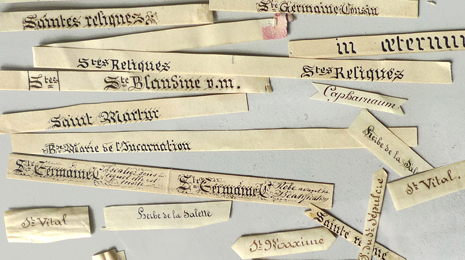
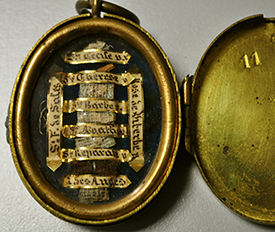
Each Carmelite could also keep a small personal reliquary entrusted during profession, as one can admire a copy opposite. THE exaction paper precise to carry it hidden on oneself.
Thérèse herself had a cult of relics from her youth, as evidenced on occasion by letters and poems, but above all by the account of her trip to Rome (Ms A, from the folio 58v). Part of the young traveler's loot has been preserved and is visible here.
Sometimes the reliquary is more ambitious and a small frame is prepared as below with several relics inside. A devotional image placed in the center completes the whole. These frames of 15 cm. X 20cm. are displayed on a wall or piece of furniture.
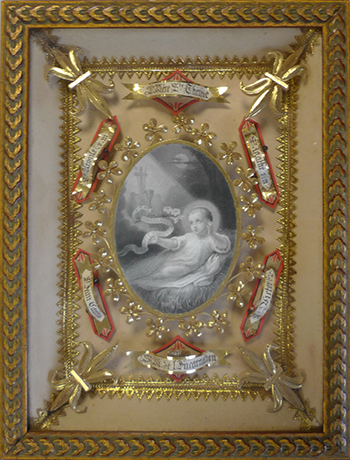

The ornamentation of these frames-reliquaries was also done with ribet. These are thin strips of cardboard turned on themselves; they are golden or colored.
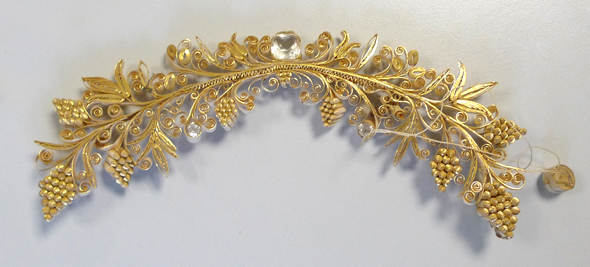
It is specialist work. We know that among Thérèse's contemporaries, it is Sr Aimee of Jesus which had been placed in the office of relics from her profession (in 1873), and was still there at the time of Thérèse's death. The different stages in the making of an individual reliquary can be seen below, with precious remains sewn on a bottom whose threads are sealed on the back, then inserted into a container, where the glass rests on a golden border, under lid.

and where do the relics come from?
Where does the content of these reliquaries come from? Several relics were offered to the Carmel by its founder and first superior, Father Sauvage. Even before the foundation, in 1837, the abbot had made a pilgrimage to Ste Radegonde, whose relics rest in the church that bears his name in Poitiers. He had touched several objects to the precious relics of the Saint.
Shortly after the founding of the monastery, Father Sauvage hastened to give his community relics which he procured with the help of his friends. He thus gives the Carmel a relic of the true Cross, part of the bones of Saint Philomena, the relics of Saint François de Sales and Saint Vincent de Paul. That same year, 1839, he gave several others relics, among others those of St Thérèse and the tomb of the Blessed Virgin.
In 1845, still via Father Sauvage, Mgr Emmanuel Vérrolles, bishop in Manchuria passing through Lisieux to see his former teacher who was none other than the abbot, offered to Carmel relics of the venerable Servants of God Charles Cornay and Mgr Pierre Borie (photo opposite on the right). Both will be canonized in 1988.

Other relics come from a wide variety of sources. According to the Foundations, after the death of Mgr Robin in 1855, the new bishop of Bayeux-Lisieux Mgr Didiot offered two bones of Saint Mercury during a visit in February 1857. And in 1861, Miss Hardouin of Caen, having her brother established in Rome, procured several relics at the Carmel of Lisieux. In 1874, the Carmel of Messina donated the relics of Ste Thérèse and Ste Geneviève. Father Roger, Sulpician, also enriches the community ofa large number of relic plots. M. Turquentin, priest of Tortisambert, gave two reliquaries containing very beautiful bones (?) and Mlle Sauvage offered the beautiful reliquary of the choir which had belonged to M. le curé of Cernay, her brother.
Finally, in 1891, the sisters possessed relics of St John of the Cross which were exhibited for the veneration of the faithful during the centenary celebrations. Perhaps they obtained them from the good Brother Siméon, who wrote to Thérèse in June:
In announcing to Madame your venerable Mother Superior that I am sending her today a few Relics, few in number, but with the well-founded hope of being able to procure others for him... You will see by the authentic ones that there are some which come to me from Parma. It is very difficult today to obtain these Holy and Venerable remains of the Servants of God. The true Cross is only given to bishops. Among my personal relics, I found a St Thérèse, patroness of my Sister, I gladly do without it for you. (from brother Siméon to Thérèse - 12th June 1891).
hair works under glass
Another type of memory brings close people, living or dead: it is a work done with hair. These are finely cut and coated with glue to be then, once dried, cut into shapes of foliage and flowers. The set is arranged in a frame of good size (about 23 cm. X 20 cm.), under glass. We see below on the right a detail of the work. These very special works of art were sold at the reception of the monastery, as can be seen in the Recipes of the account book.
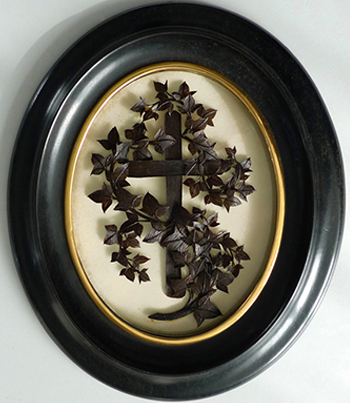

This tradition of hair work is rooted in particular in the Martin family. We can read in a letter from Mrs. Martin to Mrs. Guérin that the hair of her recently deceased sister Marie-Dosithée will be disposed of (March 4, 1877). We have kept these artistic works with hair for several family members.


